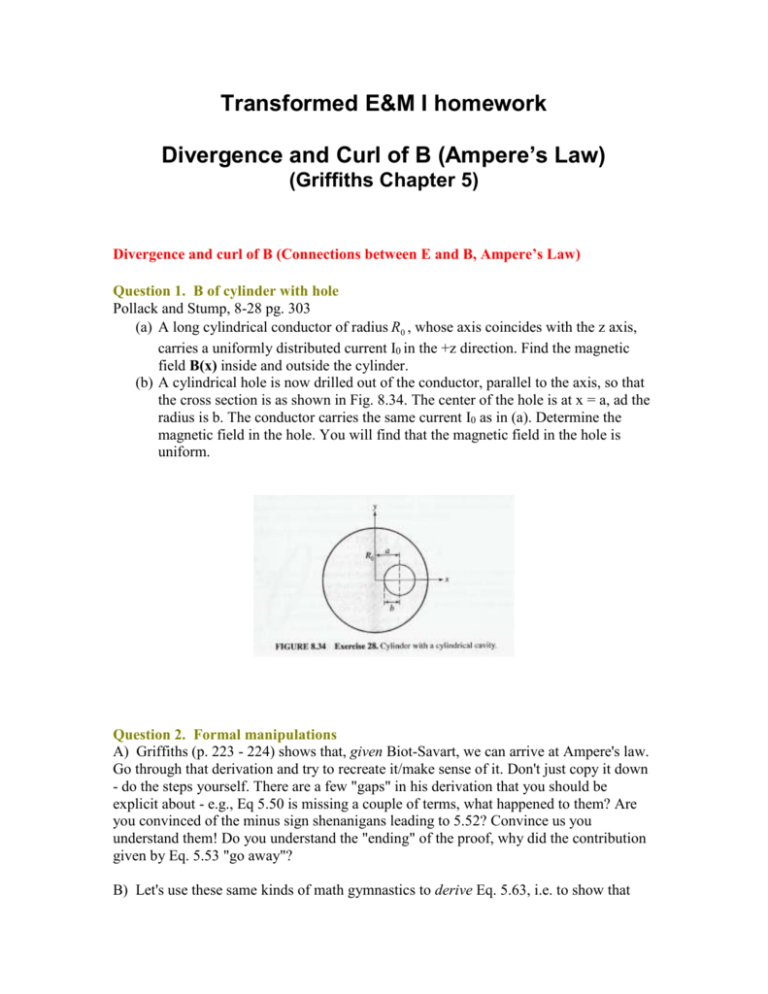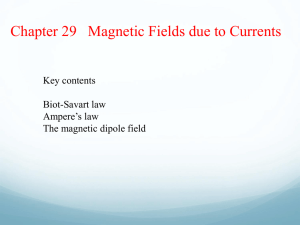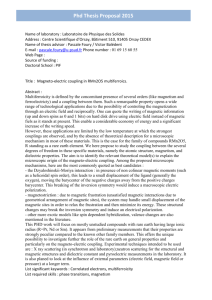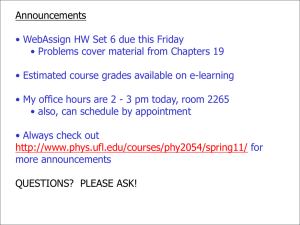Homework-Div-Curl
advertisement

Transformed E&M I homework Divergence and Curl of B (Ampere’s Law) (Griffiths Chapter 5) Divergence and curl of B (Connections between E and B, Ampere’s Law) Question 1. B of cylinder with hole Pollack and Stump, 8-28 pg. 303 (a) A long cylindrical conductor of radius R0 , whose axis coincides with the z axis, carries a uniformly distributed current I0 in the +z direction. Find the magnetic field B(x) inside and outside the cylinder. (b) A cylindrical hole is now drilled out of the conductor, parallel to the axis, so that the cross section is as shown in Fig. 8.34. The center of the hole is at x = a, ad the radius is b. The conductor carries the same current I0 as in (a). Determine the magnetic field in the hole. You will find that the magnetic field in the hole is uniform. Question 2. Formal manipulations A) Griffiths (p. 223 - 224) shows that, given Biot-Savart, we can arrive at Ampere's law. Go through that derivation and try to recreate it/make sense of it. Don't just copy it down - do the steps yourself. There are a few "gaps" in his derivation that you should be explicit about - e.g., Eq 5.50 is missing a couple of terms, what happened to them? Are you convinced of the minus sign shenanigans leading to 5.52? Convince us you understand them! Do you understand the "ending" of the proof, why did the contribution given by Eq. 5.53 "go away"? B) Let's use these same kinds of math gymnastics to derive Eq. 5.63, i.e. to show that B A , where A is given by Equation 5.63, in a different way than Griffiths does (though you should convince yourself you can see it his way too!) Start with the Biot-Savart law, written in the form of Eq 5.45 (on p. 222), and use the 1 1 ˆ handy identity we've seen several times this term: 2 (Do you know where this relation comes from, can you show it?) You'll also need Griffiths' "product rule #7 (front flyleaf)". At some point you will need to pull the curl past the integral sign - be sure to justify why this is a perfectly legitimate thing to do. Assigned in SP08 (average score: a) 8.89, b) 8.11) Instructor notes: This is an excellent question for helping students struggle with the difference between primed and unprimed coordinates and formal manipulations. For example, some students assume that J( r) should be nonzero because if something has a divergence ( J(r) 0 ) then it has a divergence everywhere, regardless of a change of origin. (But, of course, del is an operator, and that operator is testing how much something is changing with respect to the unprimed coordinates). Similarly, some students were unclear about why J( r ) vanishes, generally because they did not write down J as J(r’). Several students were not sure if/when you can move derivatives past integral signs. Part (b) was a great followup, testing to see if they had gotten those ideas. Some did not, so they still didn't know if they could move curl past the integral, or why a term the needed to vanish would vanish, exactly the same problems I'd seen in part (a). Question 3. Cancel the earth’s B field Purcell, 6-15 pg. 248 For a delicate magnetic experiment, a physicist wants to cancel the earth’s field over a volume roughly 30 X 30 X 30 cm in size, so that the residual field in this region will not be greater than 10 milligauss at any point. The strength of the earth’s field in this location is 0.55 gauss, making an angle of 30o with the vertical. It may be assumed constant to a milligauss or so over the volume in question. (The earth’s field itself would hardly vary that much over a foot or so, but in a laboratory there are often local perturbations.) Suggest an arrangement of coils suitable for the task, and estimate the number of ampere turns required in your compensating system. Question 4. Justify the direction of B (i). A thin wire carries a uniform current I. This current produces a magnetic field, B. You have always been told that magnetic fields loop around a current-carrying wire (Figure a., below), but how do you know there are no other components to the magnetic field? Perhaps the magnetic field has a z-component (Figure b.) or a radial component (Figure c.). B B B I I I Figure a. Figure b. Figure c. Think of convincing arguments for why the magnetic field should have no z- or scomponents. You may want to consider symmetry, Maxwell’s equations, and any laws that have recently been covered in class. Question 5. Semi-infinite solenoids Purcell, 6-17 pg. 248 A number of simple facts about the field of solenoids can be found by using superposition. The idea is that two solenoids of the same diameter, and length L, if joined end to end, make a solenoid of length 2L. Two semi-infinite solenoids butted together make an infinite solenoid, and so on. (A semi-infinite solenoid is one that has one end here and the other infinitely far away.) Here are some facts you can prove this way: (a) In the finite-length solenoid in part (a) of the figure, the magnetic field on the axis at the point P2 at one end is approximately half the field at the point P1 in the center. (Is it slightly more than half, or slightly less than half?) (b) In the semi-infinite solenoid shown in part (b) of the figure, the field line FGH which passes through the very end of the winding is a straight line from G out to infinity. (c) The flux of B through the end face of the semi-infinite solenoid is just half the flux through the coil at a large distance back in the interior. (d) Any field line which is r0 cm from the axis far back in the interior of the coil exits from the end of the coil at a radius r1 2r0 . Question 6. B field in particle accelerator Reitz, Milford, Christy, 8-13 pg. 215-216 The vertical component of the magnetic induction between the pole faces of a particle 1 2 accelerator is given by z z (r, z) , where r ( x y ) is the distance from the axis of the pole faces. (a) If B z is a decreasing function of r, show that the lines of magnetic intensity bow outward, as shown in Fig. 8-12, regardless of whether the upper pole is a north or south pole. [Hint: Use the fact that 0 and that r 0 on the median 2 2 plane.] (b) If the lines of B bow as shown in the figure, show that accelerated particles that drift away from the median plane experience a force tending to restore them to the median plane, regardless of whether they are positively or negatively charged. Question 7. Laplace’s equation for B Reitz, Milford, Christy, 8-15 pg. 216 For a homogeneous, isotropic, nonmagnetic medium of conductivity g, which there are steady currents, show that B satisfies the vector Laplace equation 2 0. Reitz, Milford, Christy, 8-19 pg. 215 Question 8. B of toroid and ratio of radii A toroid is wound uniformly, as shown in Fig. 11-2. It has N turns of winding which carry current I. The inner radius of the toroid is a, the outer b. (a) Find the magnetic induction at various points inside the toroidal winding. (b) Find the ratio b/a that will permit B in the ring to vary by no more than 25 percent. Question 9. B field of copper rod with hole Purcell, 6-16 pg. 248 A long copper rod 8 cm in a diameter has an off-center cylindrical hole, as shown in the diagram, down its full length. This conductor carries a current of 900 amps flowing in the direction “into the paper.” We want to know the direction, and strength in gauss, of the magnetic field at the point P which lies on the axis of the outer cylinder. Question 10. Ampere’s law The magnetic field in a region of space centered on the origin has cylindrical symmetry and is given by B B0 ˆ where B0 is a constant, where ̂ is the azimuthal direction in cylindrical coordinates. A) What is the current density in this region of space? B) Suppose the current density that you found in part (A) extends out to a radius R and is zero for r > R. What is the magnetic field for r > R? Assigned in FA08 Question 11. Ampere’s law- themes and variations Consider a thin sheet with uniform surface current density K 0 xˆ +z Consider a thin inifinite sheet with uniform surface current density K +y +x K 0 xˆ in the xy plane at z = 0. A) Use the Biot-Savart law to find B(x,y,z) both above and below the sheet, by integration. Note: The integral is slightly nasty. Before you start asking Mathematica for help simplify as much as possible. Set up the integral, be explicit about what curly R is, what da' is, etc, what your integration limits are, etc. Then, make clear mathematical and/or physical arguments based on symmetry to convince yourself of the direction of the B field (both above and below the sheet), and to argue how B(x,y,z) depends (or doesn't) on x and y. (If you know it doesn't depend on x or y, you could e.g. set them to 0... But first you must convince us that's legit!) B) Now solve the above problem using Ampere's law. (Much easier than part a, isn't it?) Please be explicit about what Amperian loop(s) you are drawing and why. What assumptions (or results from part a) are you making/using? (Griffiths solves this problem, so don't just copy him, work it out for yourself!) C) Now let's add a second parallel sheet at z = +a with a current running the other way. K K 0 xˆ . Use the superposition principle (do NOT start from scratch or use Ampere's law again, this part should be relatively quick) to find B between the two sheets, and also outside (above or below) both sheets. D) Griffiths derives a formula for the B field from a solenoid (pp. 227-228) If you view the previous part (with the two opposing sheets) from the +x direction, it looks vaguely solenoid-like (I'm picturing a solenoid running down the y-axis, can you see it?) At least when viewed in "cross-section": there would be current coming towards you at the bottom, and heading away from you at the top, a distance "a" higher. ) Use Griffiths' solenoid result to find the B field in the interior region (direction and magnitude), expressing your answer in terms of K (rather than how Griffiths writes it, which is in terms of I) and briefly compare with part C. Does it make some sense? Why might physicists like to use solenoids in the lab? Assigned in SP08 (average score: a) 8.47, b) 4.11, c and d) 4.17) Assigned in FA08 Instructor notes: Most student problems centered around the direction of B, how to set up curly R, and using the “oddness” argument to get rid of the integral over “y”. Several had questions about interpreting and evaluating the integral of a vector (how do you integrate something with three components?) which is surprising. This is a good question. Question 12. Ampere’s law II Now the sheet of current has become a thick SLAB of current. So +z we must think about the volume current density J, rather than K. +y The slab has thickness 2h (It runs from z=-h to z=+h) J +x 2h Let's assume that the current is still flowing in the +x direction, and is uniform in the x and y dimensions, but now J depends on height linearly, J J0 | z | xˆ inside the slab (but is 0 above or below the slab). Find the B field (magnitude and direction) everywhere in space (above, below, and also, most interesting, inside the slab!) Assigned in SP08 (average score: 78.3%) Instructor notes: Some students struggled with direction of the B field (as in “Ampere’s Law, Themes and Variations question). were confused about which Amperian loop to set up. A few students Question 13. Ampere and superposition A) A long (infinite) wire (cylindrical conductor of radius R, y whose axis coincides with the z axis) carries a uniformly distributed current I0 in the +z direction. b R A cylindrical hole is drilled out of the conductor, parallel to the z axis, (see figure for geometry). The center of the hole is at x = b, x a and the radius is a. Determine the magnetic field in the hole region. B) If this is an ordinary wire carrying ordinary household currents, and the drilled hole has dimensions roughly shown to scale in the figure above, make an order of magnitude estimate for the strength of the B field in that region. How does it compare to the earth's field? You should find that the B field in the hole is uniform - that was just a little surprising to me! Assigned in SP08 (extra credit- average score: 90%) Question 14. B near a conducting sheet Lorrain, Dorson, Lorrain, 15-4 pg. 272 A conducting sheet carries a surface current density of amperes/meter. There are no other currents in the vicinity. (a) What is the value of B, close to the sheet? (b) How is B oriented with respect to ? (c) A conducting body carries a high-frequency current that is confined near the surface. The surface current density is amperes/meter. Show that, in the air near the conductor, B 0 n̂ , where n̂ is a unit vector normal to the surface and pointing outward. Question 15. Stokes’ theorem in cylindrical coordinates STOKES’ THEOREM Consider the vector field written in cylindrical coordinates: A s 2 Sketch this vector function. Check Stokes’ theorem by calculating the line integral A dl around a circle of radius 2 centered at the origin and oriented in the x-y plane. Compare this to the surface integral of A over the interior of the circle. Question 16. Stokes’ theorem for butterfly net surface CALCULATION; STOKES (OSU Paradigms, Vector Fields HW 11) Question 17. Magnetic field of long wire CALCULATION (deGrand) As a rather simple example of Ampere’s law, compute the B field a distance r from the center of a long straight wire of radius R, through which a uniform current density J flows (i.e., .) Question 18. Magnetic field of infinite slab CALCULATION (deGrand) Find the B-field form an infinite slab lying in the x-y plane with thickness a in the z direction, carrying a uniform current density J in the x direction. Question 19. Magnetic field of conducting strip LIMITING CASES, INTEGRATION (deGrand) Find the B-field a distance z above the midpoint of a strip of conductor of width L lying in the x-y plane carrying a uniform current density K = I/L in the x direction. Get a general result and find simple limiting cases for z < < L and z > > L. Question 20. Magnetic field of parallel wires CONNECTIONS BETWEEN E AND B (deGrand) Recall that the magnetic field from a magnetic dipole at the origin is The potential from an electric dipole is What is ? Question 21. Cylindrical wire CALCULATION; ARGUMENT, LIMITS (OSU Paradigms, Vector Fields HW 12)







